|
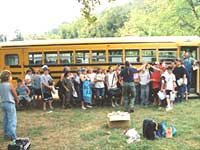 Stream
Day finally arrived! The weather was perfect. A sunny, autumn day
meant that spending the day outdoors would be a luxury. Eager to
get to Bryant Creek, my husband Bob and I donned comfortable clothing,
sturdy shoes, and sunscreen. As retired high school science and
English teachers, newly trained Master Naturalists, and volunteers
for the day, we would watch students from several area schools (Gainesville,
Dora, and Willow Springs) participate in a creek-side, hands-on
science class. Once a teacher, always a teacher, I suppose. We like
being around kids! Stream
Day finally arrived! The weather was perfect. A sunny, autumn day
meant that spending the day outdoors would be a luxury. Eager to
get to Bryant Creek, my husband Bob and I donned comfortable clothing,
sturdy shoes, and sunscreen. As retired high school science and
English teachers, newly trained Master Naturalists, and volunteers
for the day, we would watch students from several area schools (Gainesville,
Dora, and Willow Springs) participate in a creek-side, hands-on
science class. Once a teacher, always a teacher, I suppose. We like
being around kids!
When we arrived at historic Hodgson
Mill, we parked our Jeep near one of the school buses and joined
in the fun. (Teachers know that learning can be fun!) The students
had divided into four groups and were already on task. My husband
took his video camera from group to group and captured the day on
film.
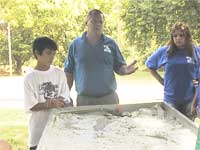 I
stood behind a group of seventh graders, who were crowded around
the stream table for the
Stream Table Activity. We all listened to MDC's Stream Team
Coordinator for the Ozarks, Bob Schulz, demonstrate how erosion
changes the landscape when the vegetation around a stream is removed.
The students answered all his questions and asked some of their
own. They exhibited an understanding of such important terms as
flood plain, watershed, riffles, pools, deposition, sediment, erosion,
and channelizing. They understood that clear-cutting causes erosion,
that channelizing creates an unstable situation, and that pollution
can be prevented. The interest they showed in the demonstration
indicated they would do their part in stopping pollution in their
streams. I
stood behind a group of seventh graders, who were crowded around
the stream table for the
Stream Table Activity. We all listened to MDC's Stream Team
Coordinator for the Ozarks, Bob Schulz, demonstrate how erosion
changes the landscape when the vegetation around a stream is removed.
The students answered all his questions and asked some of their
own. They exhibited an understanding of such important terms as
flood plain, watershed, riffles, pools, deposition, sediment, erosion,
and channelizing. They understood that clear-cutting causes erosion,
that channelizing creates an unstable situation, and that pollution
can be prevented. The interest they showed in the demonstration
indicated they would do their part in stopping pollution in their
streams.
When that hour-long session ended, the groups rotated.
I watched MDC's Dave Mayers demonstrate how to collect a water sample
from the spring and test for dissolved oxygen in the Biomonitoring
Activity. The students definitely enjoyed doing chemistry. They
showed their expertise in using test kits. They had done this before
in the lab. 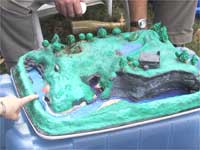 Now
they were real scientists in the field. They knew that stream life
depends on dissolved oxygen in the water. They learned that the
amount of dissolved oxygen varies, depending, in part, on where
they run the test. If they take water samples close to the spring,
there is less dissolved oxygen than if they take water samples farther
downstream. After they recorded their data in their activities booklet,
they watched Mayers demonstrate a model of how karst
topography works. They saw how streams are affected when trash
is dumped in a sinkhole or when herbicides, pesticides, and fertilizers
are used improperly. Now
they were real scientists in the field. They knew that stream life
depends on dissolved oxygen in the water. They learned that the
amount of dissolved oxygen varies, depending, in part, on where
they run the test. If they take water samples close to the spring,
there is less dissolved oxygen than if they take water samples farther
downstream. After they recorded their data in their activities booklet,
they watched Mayers demonstrate a model of how karst
topography works. They saw how streams are affected when trash
is dumped in a sinkhole or when herbicides, pesticides, and fertilizers
are used improperly.
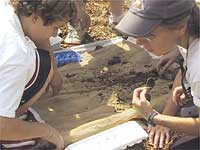 The
third session I watched was the Macroinvertebrates Activity,
led by MDC's Mary Palmer and volunteer Master Naturalist Pat Hight.
I’ve had stream team training, and I enjoyed standing on the
creek bank while the students collected and identified stream-bottom
macroinvertebrates to test the water
quality of the creek. Both boys and girls waded into the water,
used their kick nets, and carried their catch to the bank. No one
seemed a bit squeamish about placing the bugs in ice trays, identifying
and counting them, and recording their findings. The bugs that seemed
to get the most attention were the crayfish, a.k.a crawdads. But
one big hellgramite
received more than its fair share of stares. Students discussed
the diversity in the stream, knowing that the greater the diversity,
the better the water quality. Another concept, which didn’t
get past them, was that finding a hellgrammite along with other
bugs in the sensitive category means the stream is healthy. Crayfish,
by the way, are in the somewhat sensitive category while aquatic
worms and leeches are in the tolerant category. The bug collection
was returned to the creek, and the students rotated to the last
activity. The
third session I watched was the Macroinvertebrates Activity,
led by MDC's Mary Palmer and volunteer Master Naturalist Pat Hight.
I’ve had stream team training, and I enjoyed standing on the
creek bank while the students collected and identified stream-bottom
macroinvertebrates to test the water
quality of the creek. Both boys and girls waded into the water,
used their kick nets, and carried their catch to the bank. No one
seemed a bit squeamish about placing the bugs in ice trays, identifying
and counting them, and recording their findings. The bugs that seemed
to get the most attention were the crayfish, a.k.a crawdads. But
one big hellgramite
received more than its fair share of stares. Students discussed
the diversity in the stream, knowing that the greater the diversity,
the better the water quality. Another concept, which didn’t
get past them, was that finding a hellgrammite along with other
bugs in the sensitive category means the stream is healthy. Crayfish,
by the way, are in the somewhat sensitive category while aquatic
worms and leeches are in the tolerant category. The bug collection
was returned to the creek, and the students rotated to the last
activity.
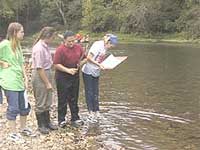 The
Stream Corridor Activity, led by MDC's Melanie Carden-Jensen,
sent students on a scavenger hunt along
both sides of the creek bank. The
Stream Corridor Activity, led by MDC's Melanie Carden-Jensen,
sent students on a scavenger hunt along
both sides of the creek bank.
Here’s what they found: Animal tracks, insects, trees, shrubs,
scat (always an interesting find) animal remains, and drink cans
(partially burned in a campfire).
Here's what they concluded:
• Stream banks are habitats; they are homes to animals.
• Clear cutting destroys animal homes.
The campfire ashes, burned cans, and fish carcasses had been left
by a group of giggers the previous night. The students concluded
that these fishermen should have cleaned up their site before they
left. Humans can impact the water quality of streams in a more positive
way than the evidence indicated those particular giggers had. Some
students speculated that the giggers had dumped their cooking oil
right there on the stream bank, instead of taking it with them,
as they should have done.
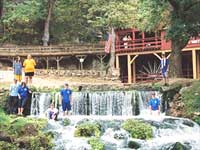 Stream
Day was a two-day event. The activities were repeated the second
day with a different group of students. The Dora High School Stream
Team (in photo at left, lounging in the Hodgson Mill spring branch)
served as volunteer aides at each activity station during the second
day. These student trainers learned the lessons on the first day
and then demonstrated their ability to lead their peers on the next
day. Stream
Day was a two-day event. The activities were repeated the second
day with a different group of students. The Dora High School Stream
Team (in photo at left, lounging in the Hodgson Mill spring branch)
served as volunteer aides at each activity station during the second
day. These student trainers learned the lessons on the first day
and then demonstrated their ability to lead their peers on the next
day.
My husband and I thoroughly enjoyed the outing. Both
of us concluded that these students will have a positive impact
on the future of area streams. I had no doubt of this when I read
the poems they wrote after they returned to school. Here’s
what two of them concluded:
We learned about the creek
And how dirty water makes bugs weak.
--Dalton Lok
Water affects us even if we’re miles away.
So help the critters start fighting today.
--Bonnie Hogue
Even this writer could not have said it in a more
memorable way!
-- Sheila Wood Foard
Master Naturalist
September 2004
|
 Stream
Days
Stream
Days  Stream
Day finally arrived! The weather was perfect. A sunny, autumn day
meant that spending the day outdoors would be a luxury. Eager to
get to Bryant Creek, my husband Bob and I donned comfortable clothing,
sturdy shoes, and sunscreen. As retired high school science and
English teachers, newly trained Master Naturalists, and volunteers
for the day, we would watch students from several area schools (Gainesville,
Dora, and Willow Springs) participate in a creek-side, hands-on
science class. Once a teacher, always a teacher, I suppose. We like
being around kids!
Stream
Day finally arrived! The weather was perfect. A sunny, autumn day
meant that spending the day outdoors would be a luxury. Eager to
get to Bryant Creek, my husband Bob and I donned comfortable clothing,
sturdy shoes, and sunscreen. As retired high school science and
English teachers, newly trained Master Naturalists, and volunteers
for the day, we would watch students from several area schools (Gainesville,
Dora, and Willow Springs) participate in a creek-side, hands-on
science class. Once a teacher, always a teacher, I suppose. We like
being around kids!
 I
stood behind a group of seventh graders, who were crowded around
the
I
stood behind a group of seventh graders, who were crowded around
the  Now
they were real scientists in the field. They knew that stream life
depends on dissolved oxygen in the water. They learned that the
amount of dissolved oxygen varies, depending, in part, on where
they run the test. If they take water samples close to the spring,
there is less dissolved oxygen than if they take water samples farther
downstream. After they recorded their data in their activities booklet,
they watched Mayers demonstrate a model of how
Now
they were real scientists in the field. They knew that stream life
depends on dissolved oxygen in the water. They learned that the
amount of dissolved oxygen varies, depending, in part, on where
they run the test. If they take water samples close to the spring,
there is less dissolved oxygen than if they take water samples farther
downstream. After they recorded their data in their activities booklet,
they watched Mayers demonstrate a model of how  The
third session I watched was the Macroinvertebrates Activity,
led by MDC's Mary Palmer and volunteer Master Naturalist Pat Hight.
I’ve had stream team training, and I enjoyed standing on the
creek bank while the students collected and identified stream-bottom
macroinvertebrates to test the
The
third session I watched was the Macroinvertebrates Activity,
led by MDC's Mary Palmer and volunteer Master Naturalist Pat Hight.
I’ve had stream team training, and I enjoyed standing on the
creek bank while the students collected and identified stream-bottom
macroinvertebrates to test the  The
Stream Corridor Activity, led by MDC's Melanie Carden-Jensen,
sent students on a
The
Stream Corridor Activity, led by MDC's Melanie Carden-Jensen,
sent students on a  Stream
Day was a two-day event. The activities were repeated the second
day with a different group of students. The Dora High School Stream
Team (in photo at left, lounging in the Hodgson Mill spring branch)
served as volunteer aides at each activity station during the second
day. These student trainers learned the lessons on the first day
and then demonstrated their ability to lead their peers on the next
day.
Stream
Day was a two-day event. The activities were repeated the second
day with a different group of students. The Dora High School Stream
Team (in photo at left, lounging in the Hodgson Mill spring branch)
served as volunteer aides at each activity station during the second
day. These student trainers learned the lessons on the first day
and then demonstrated their ability to lead their peers on the next
day.